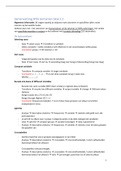Summary
Volledige samenvatting stappen SPSS (sessie 1 t/m 4) blok 2.2 Statistische vaardigheden
- Course
- Institution
Dit is een samenvatting van alle stappen die getoetst worden bij het SPSS tentamen in blok 2.2 Statistische vaardigheden. De stappen zijn per sessie 1 t/m 4 volledig uitgewerkt. Aan de hand van deze samenvatting heb ik alle SPSS stappen geoefend en geleerd en voor het tentamen een 8.7 gehaald.
[Show more]



